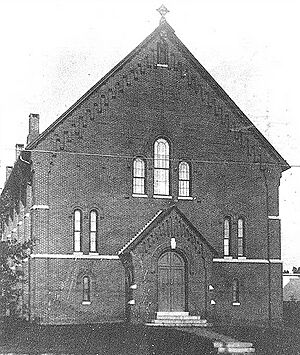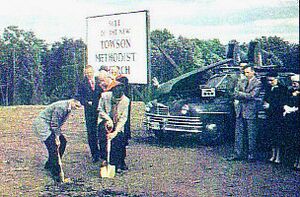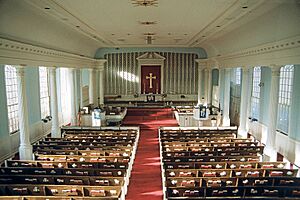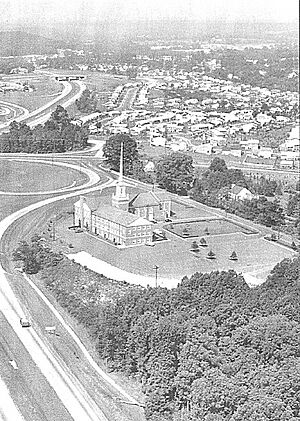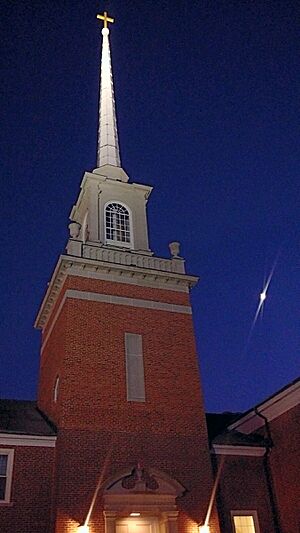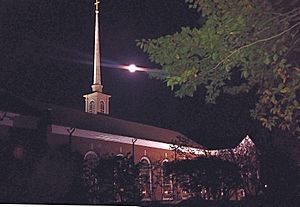Towson United Methodist Church facts for kids
Quick facts for kids Towson United Methodist Church |
|
|---|---|
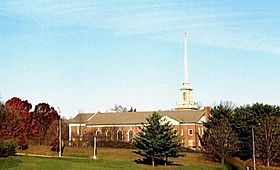
The west exterior and 235-foot (72 m) spire, viewed from I-695
|
|
| Location | Towson, Maryland |
| Country | United States |
| Denomination | United Methodist Church |
| History | |
| Former name(s) | Towson Methodist Episcopal Church (later First Methodist Church) Towson Methodist Protestant Church (later Second Methodist Church) |
| Founded | October 26, 1871 |
| Architecture | |
| Architect(s) | J. Alfred Hamme |
| Style | Georgian |
| Groundbreaking | October 7, 1956 |
| Completed | May 11, 1958 |
| Administration | |
| Division | Baltimore-Washington Conference |
| Subdivision | Baltimore Metropolitan District |
Towson United Methodist Church is a large church located in Towson, Maryland. It is part of the United Methodist Church and has a long history. The church's story shows how it grew and changed along with the United States. It even split into two groups during the American Civil War before coming back together.
Today, the church is led by Pastor Stephanie Roberts White. It is also known as Towson Church. The church offers Sunday services that mix old traditions with new music. It also has many programs to help the community. These include a child care center and a Boy Scout troop. The church supports a home for young mothers and helps with Habitat for Humanity projects. Its tall spire, about 235 feet high, is a famous landmark. People call it "the beacon of Towson" because you can see it from far away.
Contents
History of Towson Church
Early Days: 1750s to 1850s
Towson started as a small farming area in 1752. For many years, it had no churches. In the 1790s, Rebecca Dorsey Ridgely, a strong Methodist, began holding prayer meetings. These meetings took place at the grand Hampton Mansion. By 1825, the first Sunday School began in a private home.
In 1839, the people of Towson built their first church. It was called Epsom Chapel. This small church was made from stones from an old powder storage building. It opened on November 10, 1839. Early Methodist ministers, called circuit riders, would travel on horseback to preach there. As Towson grew, the chapel was shared by different church groups.
Two Churches Emerge: 1860s to 1950s
The Methodist movement grew quickly in America before the American Civil War. But there were disagreements, especially about slavery. This led to a split in 1844. One group, the Methodist Episcopal Church, was against slavery. The other group formed the Methodist Protestant Church.
In Towson, Methodists continued to worship together at Epsom Chapel. But in 1861, they disagreed about using a musical instrument in church. Some members left and formed a separate group. They met in a different hall during the Civil War.
Towson Methodist Episcopal Church (First Methodist)
The Methodist Episcopal group stayed at Epsom Chapel. They began building their own church in 1869. This new church, the Towson Methodist Episcopal (ME) Church, opened on October 26, 1871. It was a brick building with a neo-Gothic style.
The church faced money problems at first. But it grew popular, especially its Sunday school. Many young people came to learn new hymns. In 1896, the church celebrated its 25th anniversary. Later, they added beautiful stained glass windows. One famous window was Christ the Good Shepherd.
Towson Methodist Protestant Church (Second Methodist)
The Methodist Protestant group used Epsom Chapel until 1908. Then, they built their own church. It was called the Towson Methodist Protestant Church. This church was made of stone and had a bell tower.
In 1939, the two main Methodist groups in the US reunited. After this, Towson's two churches became known as First Methodist Church and Second Methodist Church.
Coming Together Again: 1950s to Today
After World War II ended in 1945, more people started going to church. By 1952, the First and Second Methodist Churches in Towson needed more space. They decided to join together. They believed that by combining their efforts, they could better serve the community.
In April 1952, the two churches voted to reunite. They officially merged on June 1, 1952. They took the name Towson Methodist Church. The members then started planning a much larger church building. They bought 16 acres of land for the new church.
The groundbreaking ceremony for the new church was on October 7, 1956. The building was finished in May 1958. A special dedication service was held on May 11, 1958. Over 1,250 people attended the event.
The old First ME Church building was later torn down in 1965. Its beautiful stained glass windows are now displayed in the foyer of the current church. The Second ME Church building was sold and is still standing today. Epsom Chapel was torn down in 1952 to make way for a parking lot. Today, only a historical marker shows where it once stood.
In 1968, the church changed its name to Towson United Methodist Church. This was to reflect a larger merger of Methodist groups in the US. In 2008, the church celebrated 50 years since its current building was completed.
The Church Building and Features
The Towson United Methodist Church building is shaped like an "L". It was designed by J. Alfred Hamme and finished in 1958. The church is made of red brick in the Georgian style. It has a tall, lighted spire with a gold cross on top. This cross is visible for miles.
The front of the church has a grand entrance made of cut stone. Inside, the sanctuary can hold up to one thousand people. It has three aisles and a balcony. Tall Corinthian columns line the sides of the pews. The pulpit and doors are made of mahogany.
The church also has a three-story wing. This wing contains classrooms, offices, a chapel, and a library. The library has historical items and records about the church. The church building cost $950,000 in 1958. This would be almost $9 million today!
Organ and Bells
The church has a large pipe organ with 2,790 pipes. It was dedicated in 1958. Many famous organ players have performed on this organ.
In 1958, an electronic carillon was also installed in the tower. This carillon has 25 bells. It is played from the organ and can be heard before and after services. It also plays hymns daily.
Updates and Changes
In 2005, the church planned to make many improvements. These included adding an elevator for easier access and a new fire sprinkler system. They also updated the climate control system in 2007.
In 2008, the church considered selling some of its undeveloped land. They wanted to use the money for future improvements. The plan was to build housing for senior citizens. However, neighbors were concerned about losing trees and increased density. So, the church and the developer decided not to go forward with the plan. The church stated they had no other plans to sell the land. In 2019, the church completed more renovations. These included a new foyer, better lighting, and updated restrooms.
Church Activities and Leadership
The main goal of Towson United Methodist Church is "To proclaim the Word of God and to make disciples of Jesus Christ". The church now calls itself Towson Church. It offers a mix of traditional and modern worship services on Sundays. The church has a staff of six people, including pastors and music directors.
Besides Sunday services, the church has Sunday school classes for all ages. There are also Bible study groups, youth activities, and midweek events. The music program includes choirs for adults and young people. There are also three handbell choirs. In the past, the church had a group called the "Alleluia Singers." These high schoolers sang for services and toured the eastern US.
Current Lead Pastor
Stephanie Roberts White became the church's first female Lead Pastor on July 1, 2021. She studied Christian Education and earned a Master of Divinity degree. Before coming to Towson, she was a minister at Pleasant Hills UMC.
Past Ministers
Many dedicated ministers have served Towson United Methodist Church.
- Mark W. Johnson (2017–2021): He was the Lead Pastor before Stephanie Roberts White. He also led mission trips to other countries.
- Roderick J. Miller (2011–2017): He studied religion and earned a Master of Divinity degree. He focused on church revitalization.
- David Cooney (2001–2011): He earned a Master of Divinity and a PhD. His father was also a Methodist minister.
- Stephen C. Rettenmayer (1995-2001): He was a talented musician before becoming a minister. He played clarinet and saxophone in the United States Marine Band. He later preached in England and was a BBC commentator.
- Walter C. Smith, Jr. (1976-1995): He was the senior pastor for 19 years. During his time, a new chapel and more classrooms were added. He also started the church's daycare center.
- John Bayley Jones IV (1965-1976): He was a strong supporter of racial integration during the 1960s.
- Lewis F. Ransom (1951-1965): He was the first minister of the unified Towson Methodist Church. He oversaw the construction of the current building. He tragically passed away in 1988 after a pastoral visit.
Helping the Community
Towson United Methodist Church is very active in helping others. It supports overseas missions and a home for young mothers. It also works with Habitat for Humanity to build homes. Church members have volunteered for groups like Meals on Wheels and Head Start. They also help at local hospitals.
For over 30 years, the church has hosted weekly meetings for Alcoholics Anonymous. Since 1999, it has sponsored Boy Scout Troop 102. This troop has helped many young men become Eagle Scouts.
The church's large size makes it a great place for community events. It hosts concerts and an annual memorial service for fallen Baltimore County firefighters. Important county officials attend this service. Famous guest speakers have also visited the church.
In 1978, Towson United Methodist Church started the Hampton Lane Child Development Center. This center provides accredited child care for about 50 children aged 2-5 years old.
Images for kids


